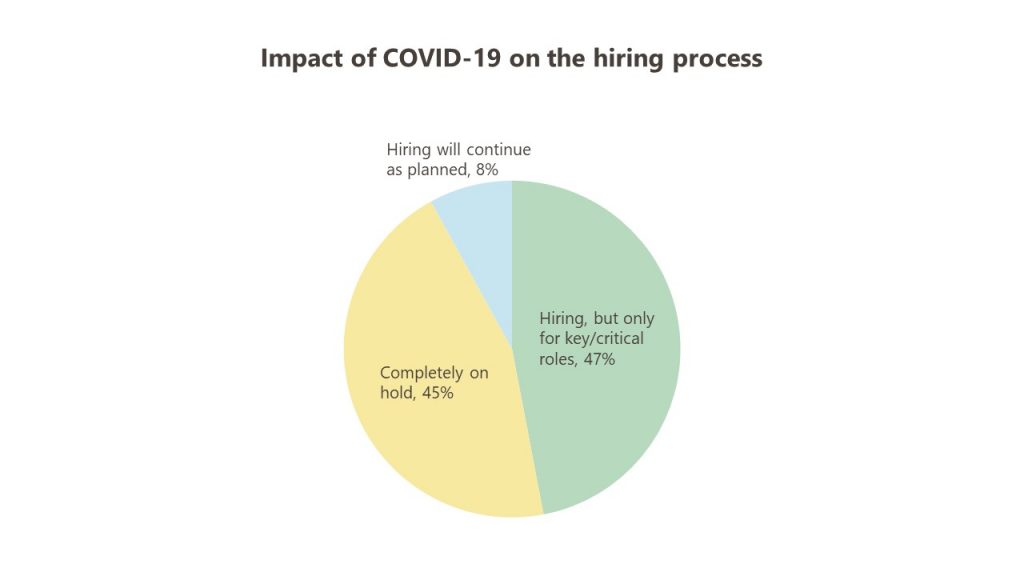How will COVID-19, and the expected imminent economic recession, affect recruitment trends for the social sector in 2020? This is a question most nonprofit leaders are grappling with today. And while there is no single answer, it is important to get a sense of what the landscape looks like, so that we are able to plan accordingly.
With this in mind, at Arthan, we surveyed 132 social sector organisations to understand what their recruitment plans were prior to COVID-19, what they look like now, and what their subsequent strategies are with regard to hiring and managing talent. Here are highlights of what we found:
Business is not as usual
Only eight percent of organisations surveyed said they planned on hiring as usual. In contrast, 47 percent of respondents indicated they would hire, but only for critical roles, and 45 percent indicated freezing hiring completely for the foreseeable future.

Source: Arthan
According to the survey, 23 percent of organisations have decided to reduce team salaries, with senior and middle management bearing the brunt of the reduction.
Organisations that are not opting to reduce salaries are either trying to raise more funds, or are giving employees the option of leave without pay. Amongst them, about 54 percent have put appraisal-related increments on hold for the time being, while 10 percent have reduced the percentage of increment. Only 19 percent of organisations surveyed are going ahead with increments as planned earlier.

Source: Arthan
Related article: Nonprofit financial planning for COVID-19
Nonprofits must look at conducting competency assessments
It is evident that recruitment, maintaining productivity and employee morale, and retention are likely to be challenging for nonprofits during this time of crisis.
Given this, it is a good time for organisation leaders to conduct a competency assessment of existing team members, and identify new programme opportunities that could exist in this current climate (for example, moving from working on relief during the lockdown to planning for long-term fallouts, or investing in tools that will enable virtual delivery). This will help determine what key skill gaps need to be filled to allow the organisation to sustain itself. Once determined, leaders can decide whether to rapidly upskill existing staff, or hire external consultants to deliver in the short- or medium-term.
When conducting competency assessments, here are some best practices to follow:
Eleven percent of organisations surveyed said they had to retract job offers, while 58 percent said they have deferred the joining date for new team members. Given this, we recommend giving virtual work-friendly positions precedence over other roles this quarter. For example, a fundraising manager who is able to work as a remote consultant might be easier to on-board and can start right away, when compared to a monitoring and evaluation manager whose role would require them to be on the ground and in the field.

Recruitment, maintaining productivity and employee morale, and retention are likely to be challenging during this time of crisis. | Picture courtesy: Rawpixel
Organisations need to assess how current team members can be retained and retrained in their new structure and/or for their pivoted programmes. For instance, how can employee capabilities be built for online and remote programming or training; or for creating programme strategy, financial modelling, and fundraising plans? Organisation continuity, the funding environment, and redundancy all need to be factored in when assessing workflows and recruitment needs for the next 12 months.
Organisations need to assess how current team members can be retained and retrained in their new structure.
With this assessment in mind, a cost-benefit analysis of bringing in a full-time resource, versus consultants, versus a firm, needs to be carried out, keeping in mind that functions such as fundraising, strategic communications, and strategy will take precedence this year. In fact, 10 percent of organisations surveyed mentioned the need to invest in aggressive fundraising as a way of maintaining finances.
Related article: Remote working: Are you ready for the new normal?
Individuals who have a track record of succeeding in unknown situations, and have the ability to handle ambiguity and bring in fresh perspectives could be invaluable for organisations looking to reinvent their programmes. Thirty percent of the surveyed organisations said that capacity building and training of team members will be a key focus area.
In the same vein, when hiring new team members, it would be beneficial to prioritise candidates who have previously worked in virtual environments, and are familiar with multiple virtual platforms, such as Microsoft Teams, Basecamp, Slack, Salesforce, Zoom, Asana, Trello, and CRMs. While most nonprofits might not have previously considered this criteria, it could now be invaluable.
Evaluating existing on-boarding processes
For organisations who are going ahead with hiring (be it either as per usual, or for critical roles), effectively on-boarding new team members will be critical to determining their success in their role. With this in mind, 42 percent of surveyed organisations are on-boarding employees using virtual meeting platforms such as Zoom, pairing new team members with mentors, providing support through regular check-ins, and hosting informal meetings to get to know the team better.
Effectively on-boarding new team members will be critical to determining their success in their role.
Nonprofits across the board need to consider measures like these and create their own virtual on-boarding manuals. Having a plan in place is crucial to ensuring that new team members feel comfortable in their roles and are able to hit the ground running. Additionally, organisations will need to create work plans for the next three months, define key performance indicators (KPIs) for the quarter, and ensure that these are clearly communicated with team members.
Over the coming months, organisations will need to reassess and reinvent themselves in order to survive, and eventually thrive. Those that are able to build and manage their teams, upskill and retain employees, and find new ways of engaging effectively with their people will be better placed to take on what lies ahead.
—
Know more
- Learn how to maximise the value of competency analytics by understanding the steps and challenges involved.
- Gain more insights into intraprenuership, and how to drive innovation within an organisation.
- Read about five ways in which recruiting teams across organisations are adjusting to the COVID-19 pandemic.
Do more
- Reach out to the author at satyam@arthancareers.com to undertake a competency mapping exercise for your organisations.





